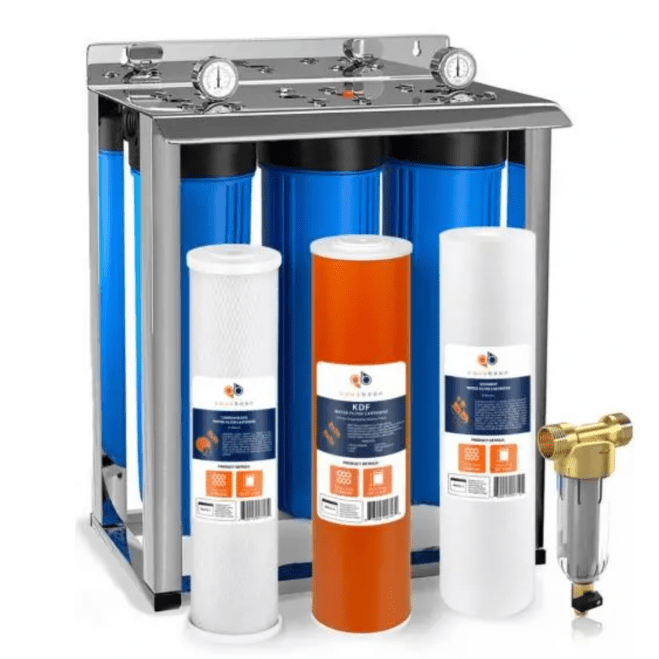What Is RO And How Does Reverse Osmosis System Work?


Pure, clean water is a precious commodity. Without access to it, over 485 000 people die every year from diseases. That being said, how do you guard your health and ensure that you're always safe?
If you live where there is no access to safe drinking water, then reverse osmosis may be something you want to look into.
But what exactly is this and how does it work? This article will answer all your questions, read on.
What is the reverse osmosis water filter?
RO systems are a type of desalination equipment that uses a semi-permeable membrane to filter pollutants out from the drinking source.
These filters help to remove salts and other filth. It can also be used to remove microorganisms and heavy metals. The equipment is typically used in homes, offices, and industrial applications.
Parts of RO water filters
They come with a series of filters to remove the filth. For better reverse osmosis understanding, it is important to know how to identify these filters.
The following are some of the parts that make up the system:
- Pre-filter. This is the first filter in the system and it is designed to remove impurities, organochlorine and organic compounds, and chlorine. It also helps the membrane to last longer.
- RO membrane. This is the part of your filter that removes most impurities. It is made up of semi-permeable membranes that allow only filtered water while blocking out any particles larger than 0.0001 microns.
- Post filter. After the process has been completed, it is important to use post filters to remove any remaining filth. These post-filters can be either carbon filters, UV cartridges, coal, or mineralizer.
What Does Reverse Osmosis Remove?
The RO system work by removing up to 99% of TDS from your water. It is a great way to get pure drinking, cooking, and cleaning water.
This process removes:
- Heavy metals (lead, cadmium, copper, iron, and zinc)
- Microorganisms (Bacteria and Viruses)
- Fluoride
- Arsenic
- Barium
- Chromium
- Cyanide
- Nitrates and Nitrites
- Chloramines
- Sodium salts and other minerals
- Lead and arsenic
- Organic compounds (including herbicides, pesticides, and synthetic hormones)
Products like KDF water filters also remove other pollutants such as cysts, algae, and parasites that may be present in your well or tap
Does RO systems waste water?
Based on the reverse osmosis explanation above, it is clear that this technology is perfect for making water drinkable. But, most first-time users are concerned about whether or not it causes waste.
The average RO system will require about four gallons of water to produce one gallon of filtered, clean water. This number is, however, determined by a number of conditions which includes filth present, TDS, and the temperature of the water. That said, the benefits far outweigh the cost of a reverse osmosis system.
The bottom line is that it really depends on the type of equipment you are using and how you are using it. This is why it is important you know much about the RO system you want to buy.
Is reverse osmosis water good for your health?
Hydration quality is a critical issue for anyone who wants to live a healthy lifestyle. If you are looking for the best water purifier, the RO filtration process is the best option.
The water is as clean as distilled water, so it can be used for any application where distilled water would normally be used. It does not contain any filth or minerals, especially when paired with melt-blown filters, so it is safe to drink and use in cooking. You can also use it for making coffee or tea without any problems.
In addition to removing organic elements, RO function by also removing most of the chemicals found in taps and wells.
Where can you use them?
Reverse osmosis works in water purification. It can be used anywhere you need to remove filth, including:
- Individual homes and businesses (Installed at the point of use [POU] such as under the sink or to the refrigerator).
- Larger buildings like apartment complexes or office buildings (In this case, a commercial or industrial reverse osmosis equipment will be needed)
- Boating facilities and RV parks
- Cruise ships
- Aquarium
There are also many other uses for the RO purification process, including:
- Water treatment plants. RO is also used at water treatment facilities. The water is treated on-site, then sent to homes and businesses.
- Drinking fountains. Drinking fountains use this system to filter out microorganisms, and other filth before it reaches your glass or cup.
How long do RO systems last?
Depending on the quality of the components used, the systems can last as long as 15 years.
This lifespan depends on several factors:
- The quality of the water going into the unit (hardness, acidity, filth)
- Membrane quality and the number of filters
- How well you maintain your system (backwashing regularly)
Conclusion
If you’re looking for a way to make purification of drinking water easy, you should think about using an RO system. They've been around for years and are perfect for removing common filth.
Reverse osmosis equipment in our online store comes in a wide range of sizes. This means that there's something that'll fit your needs no matter what kind of space you have to work within your home.













